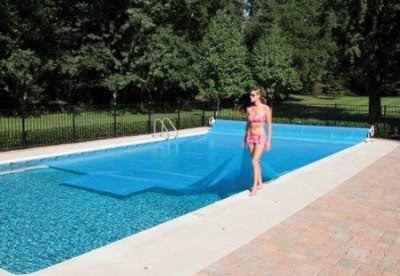Solar pool accessories such as solar covers or blankets can help you maintain the temperature in your outdoor swimming pool comfortable, extend your swimming pool season, and save money. Solar swimming pool covers made of heavy-duty polyethylene material are specifically designed to capture the sun’s free heat, transmit it to the pool water and prevents night time heat loss.

A solar pool cover is the least expensive kind of swimming pool cover. For about $75 - $150, it can raise water temperature anywhere from 10-15 degrees F, by absorbing sunlight during the day and retaining the heat at night. A solar pool cover can reduce heating costs by up to 75%.
The new generation of solar swimming pool covers let the sun’s rays to pass through to warm the water. They resemble giant colored sheets with tiny air pockets or “bubbles”. The absorbent coloring increases solar heating, while the tiny 'bubbles' magnify the sun. It is most popular to get clear or blue pool covers, but there are also black, silver and gold.
Solar swimming pool covers are classified by the thickness of the plastic they are made from. The thickness is measured in microns. The bigger the micron count the longer the cover will last.
Solar cover float freely on top of a pool without tie-down or anchor to hold it in place. You can remove a solar cover just by pull it off and store it. However, folding a giant wet blanket by yourself can be a difficult task, especially if you have a very large swimming pool, so a helper or the aid of a solar pool cover reel makes the task much easier. Solar covers are usually folded and stored or rolled-up on a large reel and wheeled out of the way.
Solar pool covers/blankets have some other benefits as well:
- they prevent water from evaporation from the pool
- reduce the amount of expensive chemicals consumed by 35 to 60 percent
- they can also help to keep the water clean and reduce cleaning time
But is important to keep in mind that although any cover will reduce some of the debris that enters a pool, solar pool covers are not specifically designed for cleanliness, nor to be used as safety covers, and access to the pool must be restricted for young children and animals. And they should be completely removed before swimming because the solar covers clings to the surface and could trap a swimmer under water.
Solar pool cover/blanket are the most practical and economical way to save on your swimming pool heating costs. They might actually be thought of passive solar heating for your pool and can be used on their own as well as in addition to a pool heating system. Solar pool covers work equally as well on both above ground and in-ground swimming pools.
Solar Pool Heater
VORTEX 4x12 Panels
Standard System Kit







